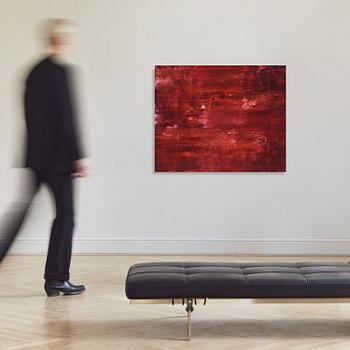Ola Billgren
'Blommor i mörkret VII'
Signed Ola Billgren and dated -96 verso. Canvas 102 x 125 cm.
Provenance
Acquired from the artist or from Galerie Leger, Malmö. Thence by descent to the present owner.
Literature
Douglas Feuk and Anne Ring Petersen, 'Ola Billgren - Måleri/Paintings', 2000, compare illustration p. 319.
More information
During his time, Ola Billgren became the first and clearest Swedish artist to formulate the relationship between art as language and reality. Called both a theorist and a sensualist, he was able to capture the historical and the contemporary in a single image. Billgren's paintings are characterised by both duplicity and ambiguity, both in expression and content, and the dreamlike present is unmistakable, ranging from the photorealistic works of the 1960s to the romantic approach of his late paintings.
Billgren's painting, Blommor i mörkret VII, brings together two important parts of his oeuvre: the photorealism of the 1960s and the fascination with light and the colour red that was so prominent in the 1990s.
In the essay " I det rödas trollkrets" Douglas Feuk describes the period in the 90s when Billgren deliberately damages or shreds his newly painted image by dragging a metal rake through the wet paint. It is an ambiguous process where destruction and painterly refinement interact. The motif, usually derived from a photographic model, is dissolved and embedded in a red light-darkness. In the latter part of the 1990s, the red register shifted towards a darker, violet colour.
This is how the artist himself expressed his red period in the catalogue that accompanied his exhibition at Galleri Engström in 1996:
"The role of painting is to be a discourse about seeing and not to classify natural things. This was at least my starting point when I began experimenting with (quasi) monochrome painting in cadmium red three years ago. At first it seemed most appropriate from the point of view of the colour experience to refrain from any representational content, but I changed my mind after a period of investigation. I had been attracted to the colour red mainly because of its paradoxical nature: it simultaneously delights and attacks, flatters and humiliates the eye.
It turned out that the interpretation of this relationship was favoured by the introduction of an operator in the form of a simple motif, such as a portrait or interior (faces, furniture, etc.), which energetically appealed to the viewer and gave a less peaceful meaning to the observation. In this way, by filling the place of the referent, I hope to say something about visual necessity: about both the will to see and the will to be seen, and also to provide an uncensored version of the symbolic register of the red. In other words, what I'm trying to do is to make the colour open up semantically through some analysis, so that its more or less given meanings are illuminated in context."
Ola Billgren is represented in several museums, including Moderna Museet in Stockholm, Göteborgs Konstmuseum, Malmö Museum, Statens Museum for Kunst in Copenhagen, Museum für Kunst- und Kulturgeschichte in Lubeck and Louisiana Museum of Modern Art in Humlebaeck. His work is also included in the collections of Lund University and the Centre Georges Pompidou in Paris.
Artist
Ola Billgren was born in 1940 in Copenhagen but based his career in Sweden. Billgren was self-taught, having only been trained by his parents Hans and Grete Billgren. Ola worked within the mediums of graphic art, watercolour, collage, photography, film, and scenography. He was also an author and culture critic. Known for his versatility, Billgren cultivated a relationship between art and reality in his work.
During the 1960s, he transitioned from abstract expressionism to photographic realism. Over time, his paintings evolved into a fusion of abstract and photorealistic styles, resulting in romantic landscapes where he examined the interplay of light and color. Forms dissolved, and colors were reduced to monochrome, single-colored surfaces that were richly worked and varied.
In the late 1980s, he returned to urban environments in large cityscapes, often painted from a high perspective but maintaining the impressionistic approach seen in his landscapes. Ola Billgren's influence on recent decades of art has been significant. His work is represented in institutions such as Musée National d'art Moderne Centre George Pompidou in Paris and Moderna Museet in Stockholm.















































